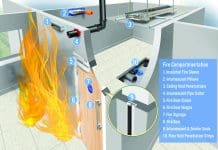Association for Specialist Fire Protection CEO Wilf Butcher explains the vital role played by passive fire protection within buildings, and outlines issues that must be considered…
Passive fire protection is critically important in ensuring safety in buildings. It is used to protect escape routes from fire and smoke and to maintain the structural stability of a building, giving building occupants adequate time to escape in the event of a fire.
Passive fire protection makes buildings safe by ensuring the building does not collapse and by subdividing it to prevent the spread of smoke and fire. It comprises those elements e.g. fire doors, walls, protection to the structural frame and protection to services passing through walls/floors which are specifically engineered to fulfil this function. In some cases, this may be in addition to their normal function in a building.
It is vital that all passive fire protection measures are correctly designed, specified, installed and maintained if a building is to behave as expected should fire break out. So what are the important issues to consider?
Legislation
Building Regulations usually deal with life safety standards for the design and construction of domestic, commercial, residential and industrial buildings. The provisions are often expanded in Statutory Guidance Documents (e.g. Approved Document B in England and Wales) which give detailed guidance on how to meet the Building Regulations. Depending on local or national regulations, alternative ways to satisfy Building Regulations can use less prescriptive methods, including the engineered approaches embodied in e.g. ISO/TR 13387-1, BS 9999 and DD 7974, which are increasingly used as designers seek more freedom to innovate in building design.
Once a building is occupied, the Regulatory Reform (Fire Safety) Order 2005 applies. This places a requirement on building occupiers/owners /employers to conduct on-going and regular assessments of the fire safety measures within a building to ensure that appropriate fire safety provision is maintained.
The construction process
During the construction process, appropriately specified materials may be substituted for cheaper, less suitable products. To compound matters, follow-on trades for example, plumbers, electricians and dry liners will regularly breach essential fire compartmentation in the process of their work and, whilst competent in their own respective fields of expertise, many of those involved will not have the required skill sets to ensure that they do not significantly compromise a fire compartment’s performance in the event of a fire. Third party certificated contractors should always be specified to undertake installation work. This will ensure that works undertaken will use appropriate materials which will be installed correctly.
Similarly, the best guarantee of the quality of passive fire protection products is by third party product certification, which links the tested/assessed product to the actual factory production and ensures traceability from raw material to finished product.
It is strongly recommended that, wherever possible, passive fire protection products should be supported by third party certification and that clients/developers, main contractors and specifiers should always require third party certification.
Handover
Regulation 38 of the Building Regulations requires that when the construction programme is completed, the main contractor must hand over to the client/ occupier the relevant fire safety information, including certificates of conformity from passive fire protection subcontractors. Information on installed passive fire protection will also need to be included in the building’s fire safety manual which should be compiled by the designer for the occupier.
Building Control Officers or Approved Inspectors should always ask to see Regulation 38 information when conducting an inspection and should remind contractors to pass this on to the building occupier on completion of the project, refurbishment or extension project. Without this information, it will not be possible to carry out suitable maintenance or conduct a suitable and sufficient risk assessment.
Maintenance
Most passive fire protection products are robust in nature and require only limited maintenance during their life which can often be the life of the building. However, there are some exceptions and some products e.g. fire doors, fire/smoke dampers and some fire resisting ducts which require inspection/ maintenance/cleaning on a regular basis. Provision must be made for this in the building’s maintenance programme.
Inspection of those parts of passive fire protection that are not in plain view e.g. firestopping of services above suspended ceilings is also vital to ensure that completed passive fire protection has not been breached by follow on trades who have not made good after their work. It is imperative that any breaches in compartmentation – however caused – are made good as soon as possible. Care must be taken in selecting an appropriately rated repair solution that is compatible with the original installation.
Wherever possible, third party certificated contractors should be specified to undertake installation and maintenance work. All Association for Specialist Fire Protection (ASFP) contractors are third party certificated. So, look for the ASFP logo and always appoint an ASFP installer.
Lack of appropriate knowledge both by those that procure fire protection installation services and those that claim to offer such services without a recognised standard of competency, can and does lead to inappropriate installations. If not detected, these will result in a building that is not fit for purpose in terms of smoke and fire performance.
If it is your responsibility to inspect or specify materials and/or appoint an installation contractor, it is also your responsibility to ensure that they can prove competency for the fire protection materials used, or the works to be carried out. You share liability for the usefulness of any system and its operation when it is needed in fire, and that liability will still be there in the event of a court case.
Available guidance
The Association for Specialist Fire Protection offers a wide range of guidance including free-to-view videos and guidance documents. The ASFP has also developed a new Passive Fire Protection (PFP) Awareness Training Programme, which aims to improve the skills of contractors involved in the installation of remedial passive fire protection, as well as the knowledge base of those involved in the design, supply, inspection and maintenance of passive fire protection. ■
For further information on ASFP training and to access a wealth of advice, technical guidance, videos and publications; all free to download, visit www.asfp.org.uk .
. . . . . . . . . . . . . . . . . . . . . . . . . . . . . . . . . . . . . . . . . . . . . . .
Wilf Butcher
CEO
Association for Specialist Fire Protection
Tel: 01420 471612





![[Video] Enhancing safety with fire doors: A case study of Marina Care Home](https://www.pbctoday.co.uk/news/wp-content/uploads/2025/06/maxresdefault-218x150.jpg)





![[VIDEO] Making DorTrak reports easy to read with Fireco Inspecting fire doors at Fireco, firedoor technology, 2023](https://www.pbctoday.co.uk/news/wp-content/uploads/2024/04/JPZ_2364-web-218x150.jpg)

